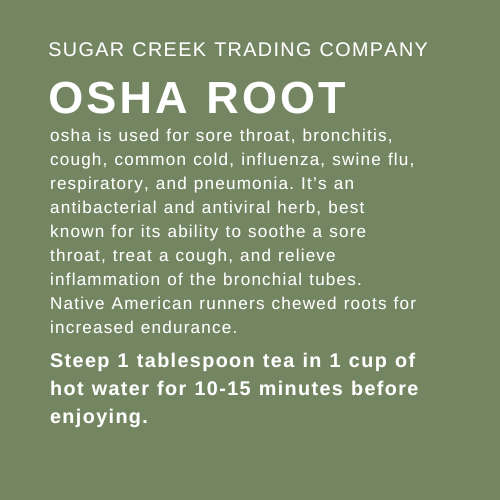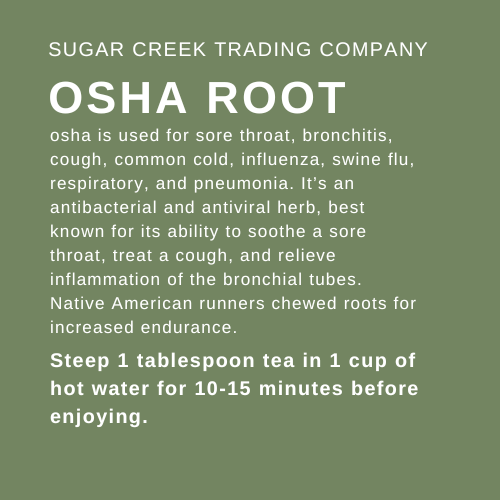Sugar Creek Trading Company
Osha Root
Osha Root
Couldn't load pickup availability
LIGUSTICUM PORTERI (OSHA ROOT)
The Respiratory Guardian—A Rocky Mountain Herb for Immune Strength, Lung Health, and Viral Defense
BOTANICAL IDENTIFICATION
Scientific Name: Ligusticum porteri J.M. Coult. & Rose
Common Names: Osha Root, Bear Root, Porter’s Lovage, Mountain Lovage
Family: Apiaceae (Carrot/Parsley family)
Ligusticum porteri is a perennial herb reaching 50–80 centimeters in height. It has hollow, furrowed stems, compound leaves resembling parsley or celery, and umbel-shaped clusters of small white flowers. The root is dark brown and fibrous with a strong aromatic scent and a pungent, spicy flavor.
Native to the Rocky Mountains and southwestern United States (from northern Mexico to southern Montana), it thrives at elevations between 2,000–3,500 meters, preferring moist, rich mountain soils and shaded forest edges.
Adaptations include high-altitude growth and a robust root system that stores volatile oils and coumarins.
CULTURAL AND HISTORICAL USE
Osha root has long been revered by Native American tribes including the Navajo, Zuni, and Apache as a sacred respiratory and protective herb. It was burned as a smudge for purification, worn as an amulet to ward off illness, and chewed to support lung health and energy during long hunts.
In Hispanic folk medicine, it became a staple remedy for coughs, colds, and flu, often prepared as a tea or syrup.
Modern herbalists value it for supporting immunity, easing sore throats, and improving lung function during viral or bacterial infections.
KEY BIOACTIVE COMPOUNDS AND BENEFITS
| Compound | Role in Plant | Human Benefits | Regional Variation |
|---|---|---|---|
| Z-ligustilide | Aromatic phthalide | Anti-inflammatory, antispasmodic | Higher in mature roots |
| Coumarins (e.g. isoimperatorin) | Defense and aroma | Antiviral, expectorant | Variable with altitude |
| Polyacetylenes | Antimicrobial compounds | Antibacterial, antifungal | Concentrated in root bark |
| Volatile Oils | Aromatic constituents | Decongestant, respiratory stimulant | Peak levels in late summer roots |
These constituents work synergistically to clear mucus, fight infections, and improve respiratory circulation.
HOW IT WORKS IN THE BODY
Volatile oils in Osha root act as natural decongestants, opening airways and increasing oxygenation.
Coumarins exhibit antiviral and antibacterial activity, particularly against respiratory pathogens.
Z-ligustilide and polyacetylenes reduce inflammation in the bronchi, easing cough and sore throat while stimulating expectoration of mucus.
The warming, pungent taste also stimulates circulation, supporting immune response and faster recovery.
DOSE GUIDELINES
| Preparation Type | Typical Dose | Purpose |
|---|---|---|
| Decoction (root) | 1–2 grams simmered 15–20 minutes | Acute colds, respiratory congestion |
| Tincture (1:5) | 1–2 milliliters up to 3 times daily | Immune support, lung health |
| Chewed Fresh Root | Small 0.5–1 cm piece (as needed) | Quick relief of sore throat and cough |
For long-term immune strengthening, lower daily doses are used over several weeks.
PREPARATION AND USES
Traditionally chewed raw or brewed as a warming tea with honey for colds and flu.
Modern formulas combine Osha root with elderberry, thyme, and elecampane for respiratory tonics.
It is also used in throat lozenges, herbal cough syrups, and as a tincture blended with echinacea for viral defense.
OPTIMAL CONTEXT FOR USE
Best used at the onset of respiratory infection to prevent deeper lung involvement.
Especially valuable for those prone to seasonal colds, bronchitis, or respiratory inflammation.
Can be paired with steam inhalation or warm compresses for enhanced decongestant action.
SUSTAINABILITY AND ETHICAL HARVESTING
Ligusticum porteri is increasingly at risk due to overharvesting and habitat loss in the wild.
Roots take years to mature, and improper harvesting can devastate local populations. Ethical harvest guidelines recommend taking only partial roots and leaving crown segments to regrow.
Cultivation is challenging but ongoing efforts are underway to propagate Osha on farms. Support suppliers committed to sustainable and Indigenous-approved sourcing.
SAFETY AND CAUTIONS
Generally safe when used at recommended doses.
Avoid during pregnancy due to uterine-stimulating properties of certain coumarins.
Use caution in individuals on anticoagulant therapy, as coumarins may have blood-thinning effects.
High doses can cause gastrointestinal discomfort or nausea.
REFERENCES
Moerman, D. (1998). Native American Ethnobotany. Timber Press.
Hoffmann, D. (2003). Medical Herbalism. Healing Arts Press.
Tilford, G. (1997). Edible and Medicinal Plants of the West.
American Herbal Pharmacopoeia (2020). Osha Root Monograph.
FINAL NOTE
Ligusticum porteri is a mountain guardian—its pungent root clears the lungs, sharpens the breath, and bolsters immunity. A sacred plant of strength and protection, Osha root reminds us of the resilience needed to thrive in the face of harsh winds and illness.
Share

